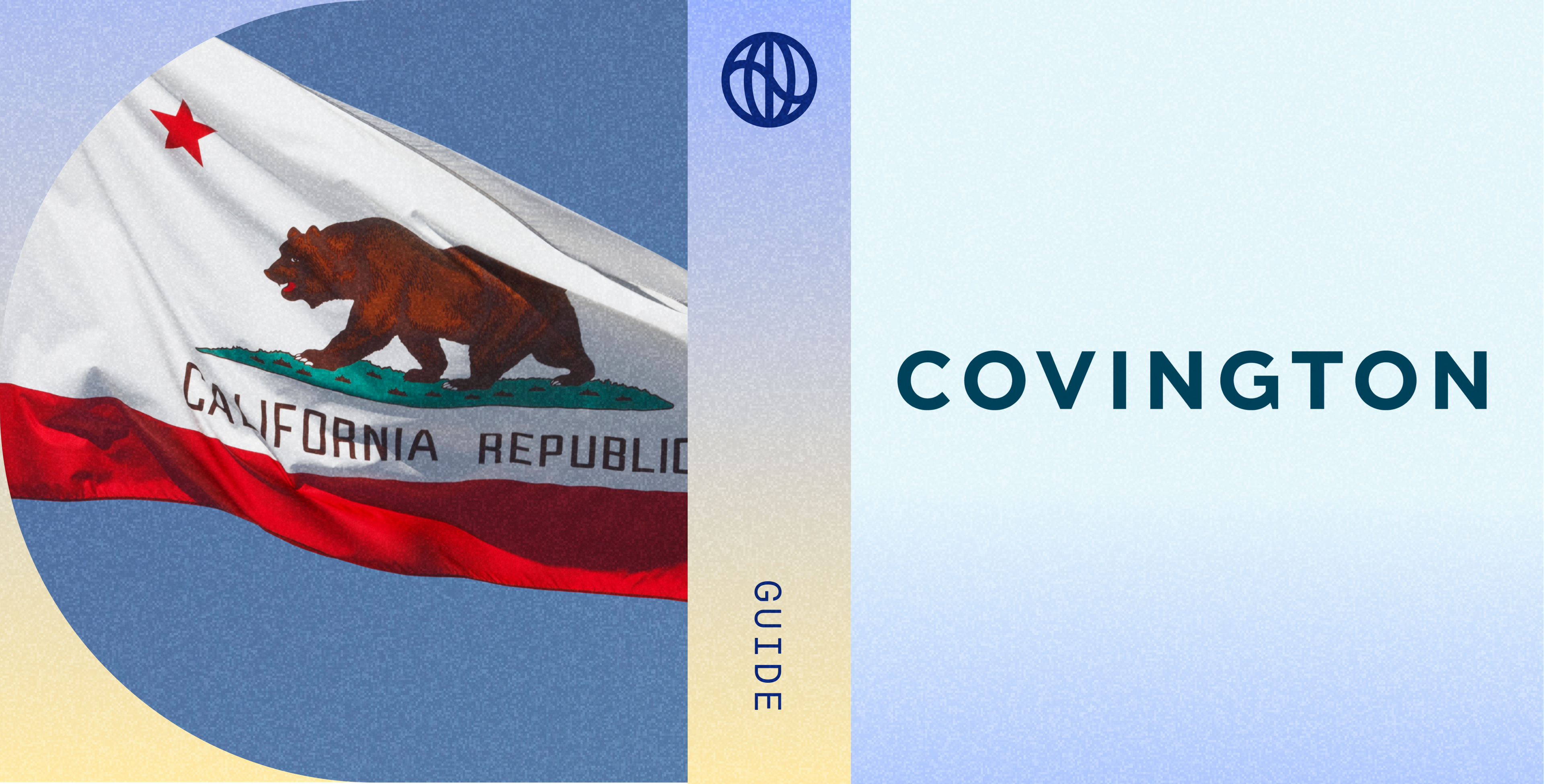

As of October 2023, California Assembly Bill 1305 is now law as the Voluntary Carbon Market Disclosures Business Regulation Act (VCMDA). The VCMDA will come into effect on January 1, 2024 with new disclosure requirements related to voluntary carbon offsets, as well as for environmental claims such as carbon neutrality and net zero emissions.
These requirements join the new greenhouse gas (GHG) emissions and climate risk disclosure rules contained in SB 253 and SB 261 (the California Climate Accountability Package), marking a significant new era of mandatory climate related disclosure for companies operating in California.
VCMDA arrives as companies face increased scrutiny on the quality of offsets used to support environmental claims, and it is likely to prompt companies to focus on aligning marketing claims with real emissions reductions, and higher-quality offsets and carbon removals.
While much of the VCMDA focuses on offsets, it also contains broadly applicable disclosure requirements for companies that make claims regarding carbon neutrality, net zero emissions, or GHG emission reductions associated with their business or products. These requirements apply even to companies that do not sell or use carbon offsets.
Members of Covington & Burling’s ESG practice joined Watershed to answer questions on what companies need to keep in mind as California’s VCMDA comes into effect.
Jayni Hein co-chairs Covington’s Carbon Management and Climate Mitigation industry group. She served as the Senior Director for Clean Energy, Infrastructure & the National Environmental Policy Act at the White House Council on Environmental Quality before joining Covington. Leveraging her senior government experience, Jayni advises companies and investors on energy and climate regulation and ESG compliance and strategy in light of increased scrutiny of corporate climate commitments.
Kevin Poloncarz co-chairs Covington’s ESG Practice and Energy Industry Group. He focuses on policy, litigation and transactional matters concerning power and carbon markets, carbon dioxide removal (CDR) technologies, carbon capture, utilization and storage (CCUS), sustainable aviation fuel, and clean hydrogen. He teaches Climate Law and Policy at Stanford Law School.
Why did California pass the VCMDA?
The VCMDA was passed on the heels of growing scrutiny regarding climate-related claims and anti-greenwashing regulatory attention in the U.S., at the state level, and internationally. This scrutiny has been particularly acute with regard to the voluntary carbon market, which has long been decentralized and largely unregulated. There is no clear, standardized definition for high quality carbon offsets, and as approaches rapidly evolve, there has not been a clear way for companies to report on or measure the impact of carbon offsets.
Quick note on terminology: The VCMDA uses the terms “voluntary carbon offsets” or “offsets,” which are umbrella terms to represent different types of carbon credits. These credits vary across a spectrum of real-world impact and availability. The new California law requires disclosures concerning both of the main types of carbon credits:
- Carbon avoidance credits are a mechanism to fund projects that result in “avoided” emissions by compensating someone else to not emit—such as paying landowners to prevent deforestation.
- Carbon removal is distinct from carbon avoidance. Carbon removal credits fund projects that remove carbon from the atmosphere and sequester it.
Read more on these two main types of carbon credits here and how Watershed vets voluntary carbon offsets here.
In the past year, there has been increasing scrutiny and criticism of some carbon avoidance offsets. In January 2023, the Guardian claimed that 90% of certain carbon avoidance offsets issued as a result of avoided deforestation did not achieve their claimed benefits. Some companies have seen lawsuits over their use of these avoidance-based carbon offsets to support marketing claims; other companies have suspended plans to purchase and rely on avoidance-based carbon offsets.
At the same time, there have been promising initiatives to improve the integrity of the voluntary carbon market on both the “supply” side (for carbon-crediting programs) with the Integrity Council for the Voluntary Carbon Market (ICVCM), and the “demand” side (for companies that use carbon credits) with the Voluntary Carbon Markets Integrity Initiative (VCMI). These initiatives could both reduce the possibility of greenwashing and make it easier for companies to focus on voluntary carbon offsets that make greater, more transparent, and more durable impacts.
While significantly reducing greenhouse gas (GHG) emissions is still the primary imperative, scientific consensus (as reflected in the latest IPCC report) is that we will also need large-scale carbon dioxide removal in order to meet global climate targets. To achieve companies’ own climate targets, companies need to reduce their own GHG emission and often must also purchase carbon offsets to reduce the impact of residual emissions—with many companies focusing on carbon removal credits to maximize additionality and impact by capturing and storing carbon dioxide from the Earth’s atmosphere.
Who does the VCMDA apply to?
Public and private companies that operate in California are subject to the VCMDA’s offset disclosure requirements and broader disclosure requirements concerning climate-related claims. And unlike companion laws SB 253 and SB 261, the VCMDA has no annual revenue threshold associated with its disclosure obligations.
The VCMDA applies to both the “supply” and “demand” sides of carbon offsets. On the “demand” side, the VCMDA applies to companies that use carbon offsets and “operate within the state.” Similarly, the law’s disclosure requirements concerning climate-related claims, such as the achievement of net zero emissions, apply to entities that operate within the state or make claims within the state.
While “operate within the state” is not clearly defined in the law, California has historically taken an expansive approach that leans towards requiring companies with even relatively low amounts of business to comply with state regulations. For instance, the California Air Resource Board’s Truck and Bus Regulation defines operating within the state as any truck with >1,000 miles or >3 days driven in California per year. Similarly, the California Revenue and Tax Code defines “doing business” to include entities organized or domiciled in California or an entity with California sales over $610,395 or property or payroll over $61,040 (in 2020 dollars).
Nothing in the text of the VCMDA excludes application of its requirements to companies operating internationally that also operate in California or make climate-related claims within the state; as a result, this law could result in disclosure obligations for international companies, including with respect to carbon offsets and climate-related claims.
What do companies need to disclose under the VCMDA?
On the supply side, programs selling carbon credits need to disclose details on projects like how emissions reductions or removals were estimated, where the project was located, and whether the project has third-party validation.
More notably, on the demand side, the VCMDA introduces reporting requirements for entities that operate within the state and purchase or use carbon offsets to achieve claims regarding net zero emissions, carbon neutrality, or GHG reductions.
Specifically, the VCMDA requires companies to disclose more granular information on their website and to provide more specificity on their net-zero or GHG emission reduction plans, with disclosures updated at least annually.
For every project a company relies on carbon offsets and makes climate-related claims, the company needs to disclose:
- The name of the business entity selling the offset
- The project identification number (if applicable)
- The project name as listed in the registry (if applicable)
- The offset project type—e.g., avoiding deforestation or direct air capture—and whether the project was carbon removal, carbon avoidance, or a combination of both, as well as the site location
- The protocol used to estimate emissions reductions or removal benefits
- Whether there is independent third-party verification of company data and claims listed
For companies that operate within the state and make climate-related claims, regardless of whether they use carbon offsets or not, the VCMDA requires information documenting how, if at all, a “carbon neutral,” “net zero emission,” or other similar claim was determined to be accurate or actually accomplished, how interim progress toward that goal is being measured, and whether there is independent third-party verification for such claims. This information is to be posted on the company’s website, with disclosures updated at least annually.
If a company has a longer term target (e.g., net zero by 2040) and has begun purchasing carbon offsets as initial progress towards a net zero goal, but isn’t making a current claim on having achieved carbon neutrality or net zero, that company may need to disclose certain information, depending on the specific claims at issue. For example, while the VCMDA references “achievement” of net zero emissions, Section 44475.2 also describes providing information on how “interim progress” towards goals will be measured.
How do you expect companies to respond to the VCMDA?
Because of its far-reaching disclosure requirements, the VCMDA should prompt companies to take a close look at their climate-related claims and targets, their use of carbon offsets, and the quality of any such carbon offsets.
With regard to carbon offsets, companies will likely focus on characteristics that indicate higher quality and greater impact:
- Additionality—i.e., what the incremental impact of having bought the offset is, and assurance that the environmental benefit would not have occurred without the purchase;
- Permanence—i.e., how long will the impact last into the future; and
- Verification—i.e., how can one be sure the project is removing as much carbon as it claims.
Beyond raising the bar on the quality of carbon offsets they purchase, companies will also likely take a closer look at their current climate plans, targets, and related green marketing claims to make sure that their targets are achievable and that their claims are accurate and not overstated. Companies may also focus more closely on concrete near- and medium-term goals given the requirement to share “interim progress” towards goals.
What penalties exist under the VCMDA, and what risks exist beyond technical penalties?
The VCMDA provides that companies are subject to a penalty of up to $2,500 per day, not to exceed $500,000. And civil enforcement actions can be brought in the name of the people of the State of California by the Attorney General or by a district attorney, county counsel, or city attorney in a court of competent jurisdiction.
In light of the VCMDA, as well as existing liability frameworks, companies now face heightened scrutiny and potentially greater risk where there is misalignment between their climate-related claims and their actual emission reduction plans, including from potential overreliance on low-quality offsets. Companies should closely scrutinize how they are positioned and consult with legal experts to mitigate risks and ensure that future claims and disclosures comply with the new requirements.
How does the VCMDA interact with other regulations, like the EU’s Corporate Sustainability Reporting Directive (CSRD)?
The EU’s CSRD similarly requires companies to make detailed disclosures about carbon offsets, including on the quality standard they rely on, whether removals are from biogenic or technological sinks, and whether the offset projects are in the EU.
Beyond other ESG regulations, the VCMDA also interacts with consumer protection laws—like California’s Unfair Competition Law and the Federal Trade Commission Act and the associated Green Guides—that allow consumers or agencies to sue over inaccurate or deceptive claims.
Due to these regulations, global companies will need to monitor regulatory trends across jurisdictions and ensure a globally consistent approach to carbon offsets and climate-related claims, as they align relevant disclosures to different reporting regimes.












